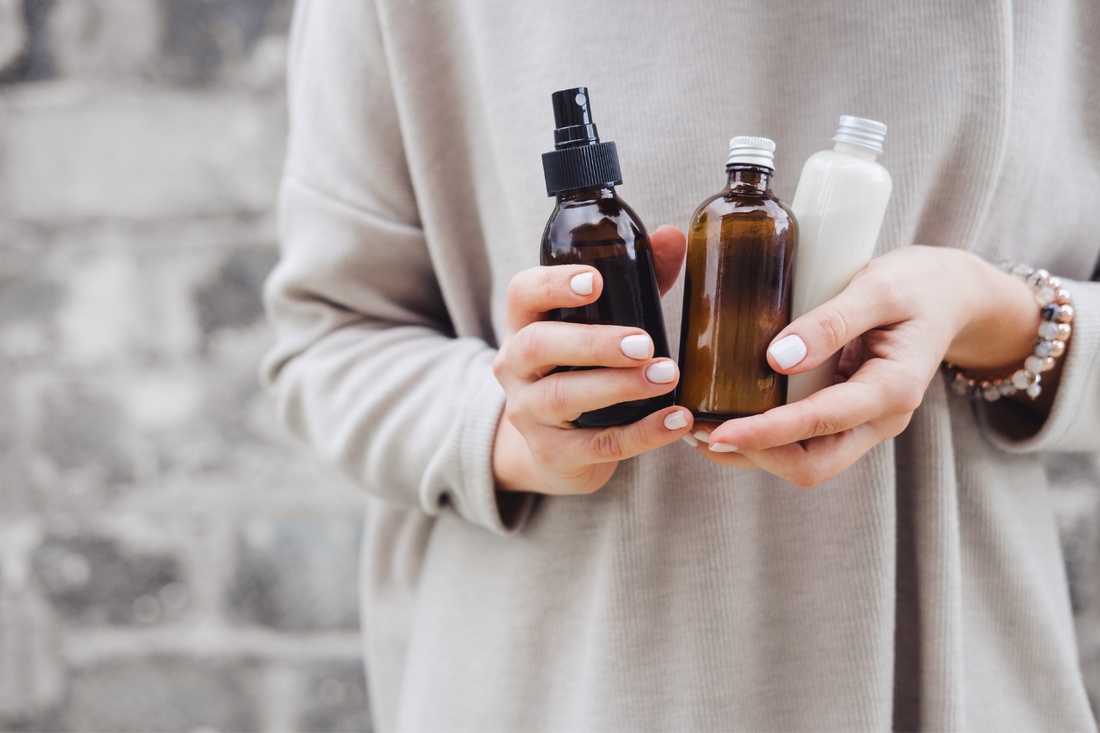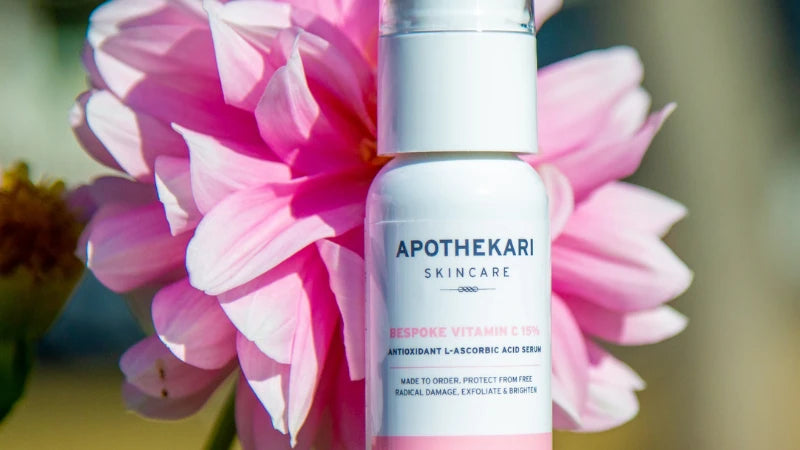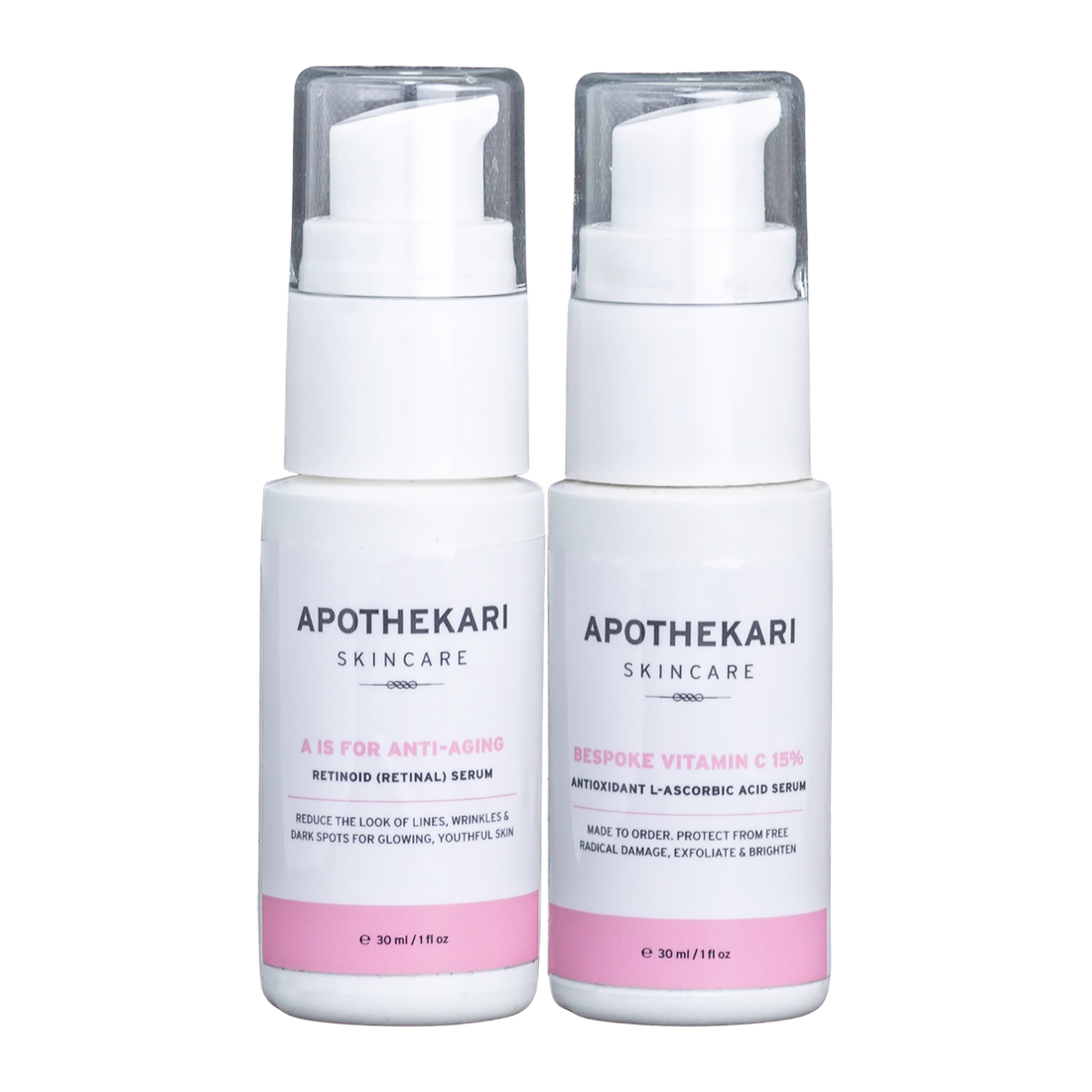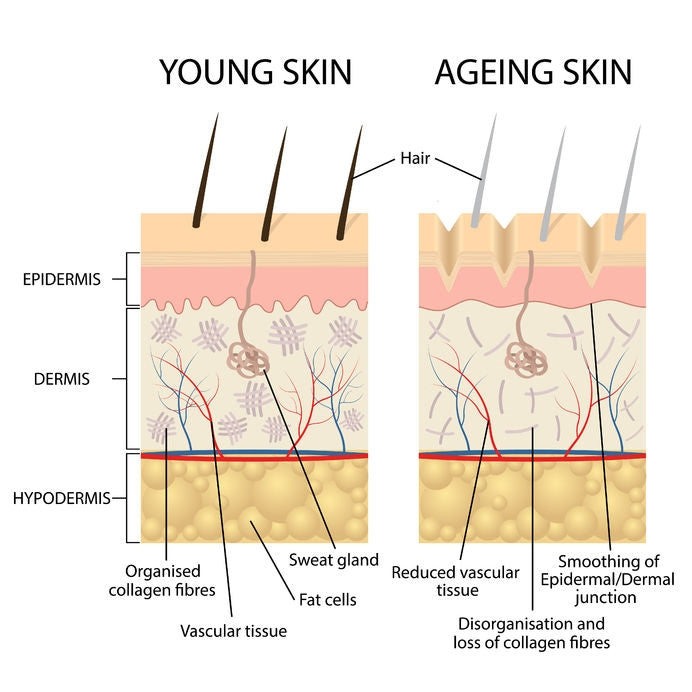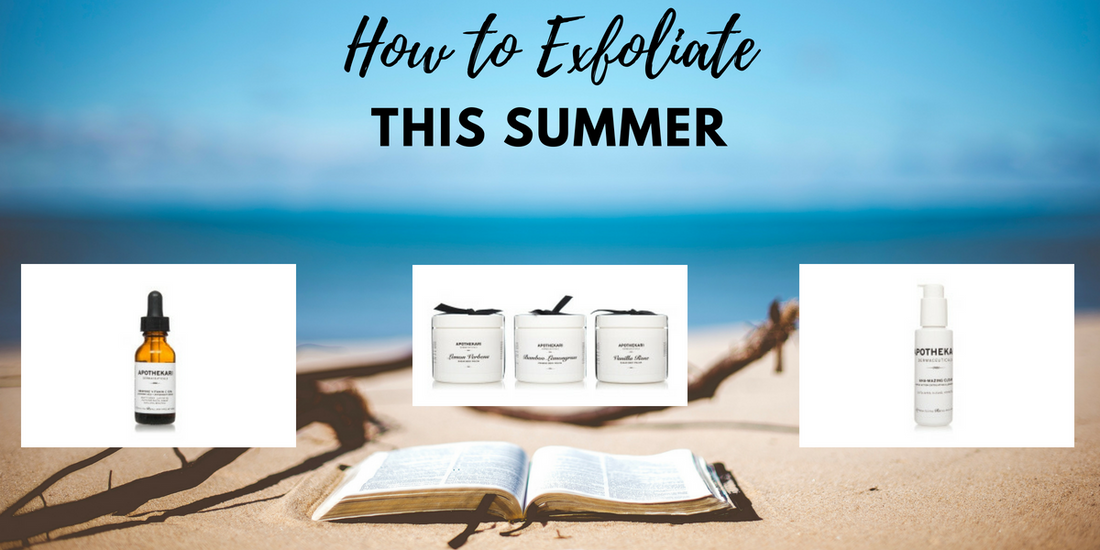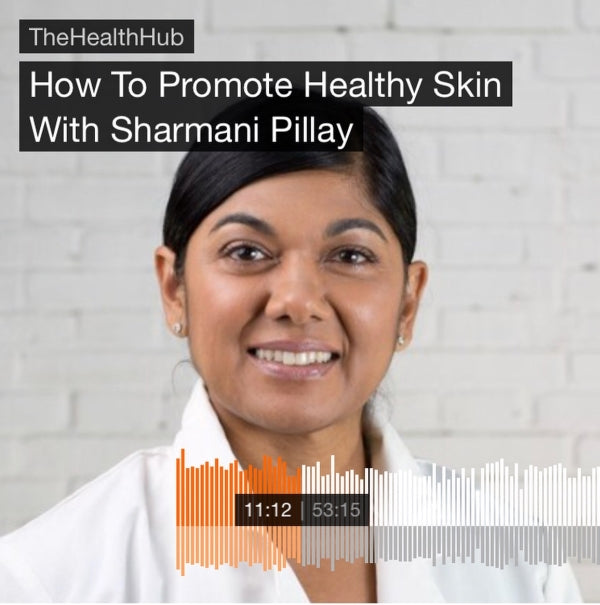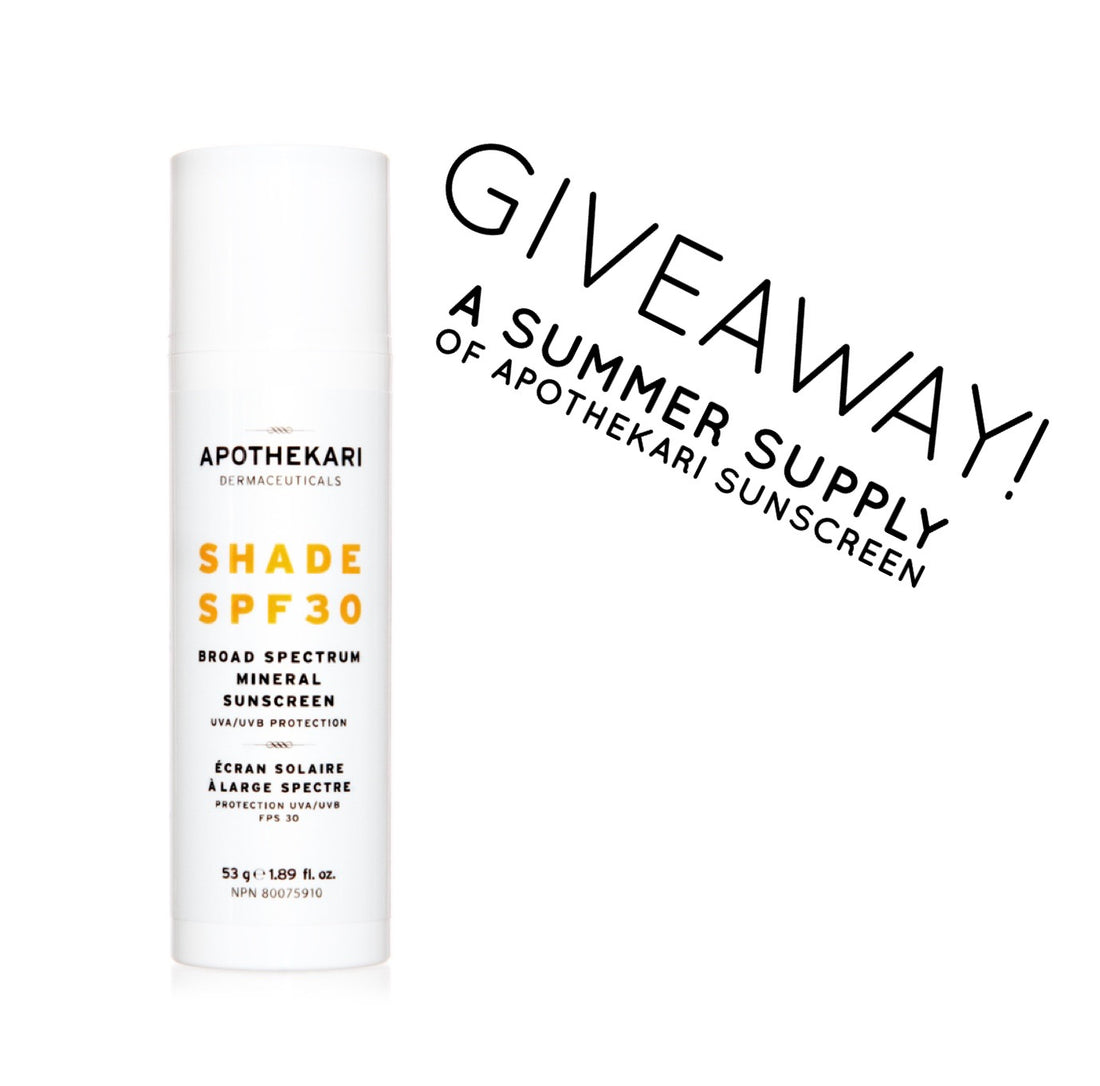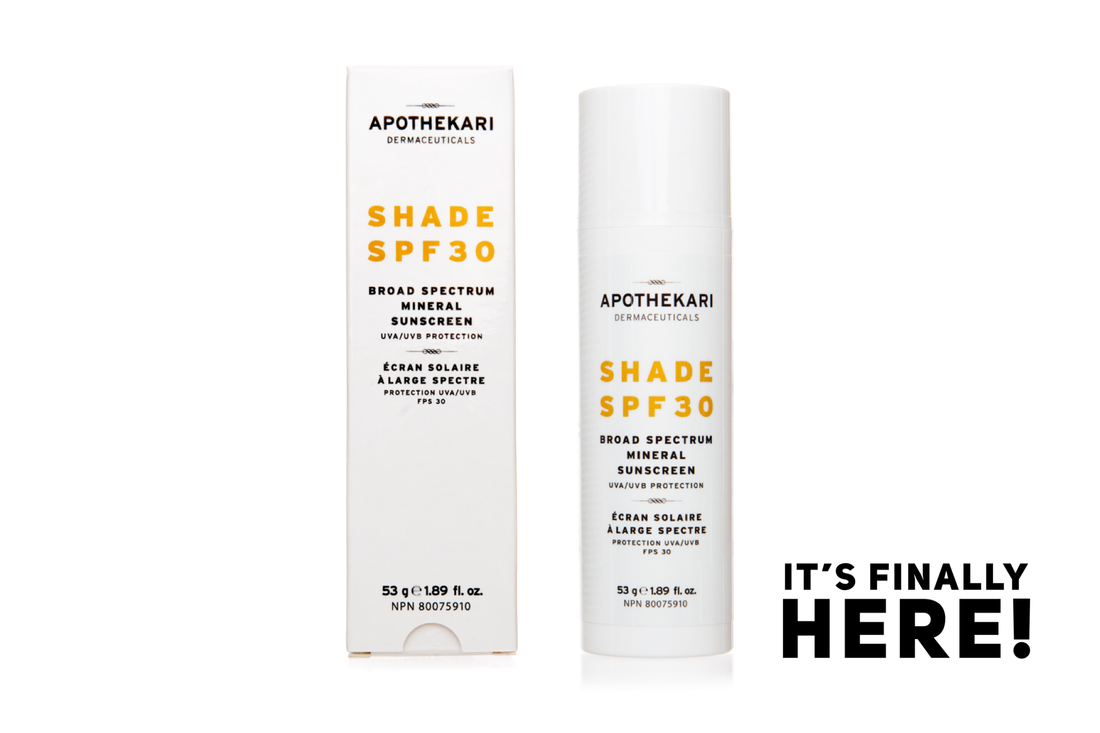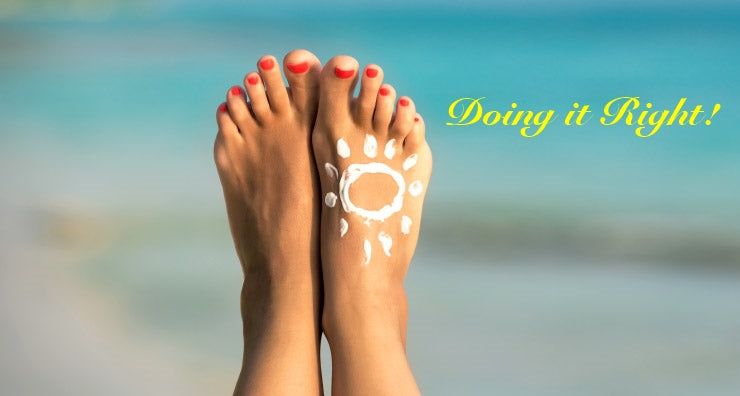Blog
Preservatives in Skin Care – 5 Things To Know
The use of preservatives in skin care can be a confusing topic. On the one hand, you’ll hear about how preservatives are associated with side effects. Yet, other companies and scientifically minded individuals (like me) express concern over the safety of cosmetics promoted as being ‘preservative free’. It’s getting confusing out there! In this post, let’s take a closer look at preservatives in skin care to help you understand why preservatives are important and how to choose products that are as safe as can be. Here are five things that will help you navigate the cosmetics counter without a science degree. 5 Tips to Navigate the Cosmetics Counter 1. If A Product Contains Water, It MUST Have a Preservative Many cosmetics contain water and when water is present, it contributes to the growth of mold, bacteria and fungi. Even if the formulation doesn’t contain water, cosmetics are often kept in humid environments and may be contaminated when your hands touch the contents. Preservatives help to prevent the growth of these dangerous substances. 2. Not All Chemical Preservatives Are Bad While chemical preservatives may be problematic in high doses, the quantities used in cosmetics are minimal, generally less than 1%. The main concern is with preservatives that cross over into the blood stream where they may lead to side effects. The following are ones we should watch out for: Phenolic acid (Phenol). In large quantities, it has been known to cause respiratory issues, coma, fainting, and even paralysis. Phthalates: Phthalates can be absorbed through the skin and accumulated in the body. They are associated with the development of breast cancer, asthma, ADHD, obesity and Type 2 diabetes, neurodevelopmental issues, behavioral issues, autism spectrum disorders, altered reproductive development, and fertility issues. Petroleum-based compounds: Some (propylene glycol, polyethylene glycols, or polyoxyethylene) can be contaminated with 1,4-dioxane, a chemical that the FDA says may cause cancer. However, it’s important to note that most cosmetics companies these days will test for this before using it so it isn’t as big as an issue as it once was. Formaldehyde: This is a carcinogen and can cause allergies, irritation, and asthma. 3. Beware of Paraben Free Labels Although many companies (Apothekari included) are moving away from the use of parabens in their products, the alternatives may not necessarily be better. (see the list of ones to avoid in number 2, above). Parabens have estrogenic activity and this effect has been linked to fueling the growth of existing cancer cells. Some studies have shown them to be carcinogenic (cancer causing) as well. The science isn’t conclusive and parabens are just one of many chemicals we’re all exposed to on a daily basis. However, we feel that in this case, it’s wise to exercise caution especially when safer alternatives exist. 4. Preservatives May Not be Listed on the Label Unfortunately for us, some companies play the game of misleading consumers by not listing preservatives on their label even when their formulations contain them. Yup, it happens! This kind of disingenuous marketing isn’t as uncommon as you may expect and you can be duped into thinking that the product you’re purchasing is ‘preservative-free’ when in fact it isn’t. 5. Natural Preservatives are NOT Necessarily Better The word ‘natural’ isn’t regulated when it comes to cosmetics so it doesn’t really mean anything. Natural preservatives are not necessarily safer and they may be less effective than conventional ones. Safer preservatives include food grade preservatives (like potassium sorbate and sodium benzoate); alcohols (organic ethanol, grape alcohol, benzyl alcohol, and witch hazel); and a short list of others that are sourced from plants (like gluconolactone, ethylhexyglycerin, triiostearyl citrate) and some that are synthetic but non-toxic preservatives, like dehydroacetic acid. However, you may require natural preservatives in larger concentrations than chemical ones. They may also have heavy smells and textures that many chemical ones lack. Chemical preservatives are often cheaper, more efficient, more predictable and often associated with fewer allergic reactions. If your health and safety are important, ensure that there are preservatives in skin care products that you and your family use. Inadequate preservation will not only make products smell and look bad but may introduce dangerous organisms to your body that can lead to severe health issues including blindness. Additionally, since cosmetics are often stored in warm and moist environments, we are creating a breeding ground for bugs. Unless a product is completely oil based, preservatives are essential and non-negotiable. The topic of preservatives in skin care is so confusing, so you may wonder what to do. First, read labels and go with companies that you trust. By becoming an informed consumer, you’ll be able to rely on facts and not be swayed by marketing. You can read more about our ingredients philosophy, including the use of preservatives in our line here.
Learn moreHow To Choose A Vitamin C Serum
If I had to make a list of my favorite skin care products, a Vitamin C Serum would get top billing. That, along with an SPF 30+ sunscreen and a retinoid treatment, would round out the list of my three must-haves. Shop Bespoke Vitamin C 15% We know Vitamin C as the vitamin that prevents scurvy, but it’s also essential to our overall health, including that of our skin. Today’s post is dedicated to this amazing, superstar ingredient. Let’s take a closer look so that you know how to find a Vitamin C serum that’s just right for you and your skin. Shop Bespoke Vitamin C 10% What Should I Look For When Choosing Vitamin C Serum? I’ve written about Vitamin C and its skin benefits before, but in this post, let’s get into the nitty gritty. While ascorbic acid/ L-ascorbic acid is the form of Vitamin C that is most well known, it is also available in several other forms. When it comes to skin care, you may find sodium ascorbyl phosphate, ascorbyl palmitate, retinyl ascorbate, tetrahexyldecyl ascorbate, magnesium ascorbyl phosphate, and ascorbyl glucoside along with others included in a range of products such as serums, lotions and moisturizers. All of these forms have skin benefits, but none compare to l-ascorbic acid when it comes to the amount of research and clinical studies to back up its use in skin care. For that reason, it’s the form of Vitamin C we love most at Apothekari and why you’ll find it included in our Bespoke Vitamin C Serums. Vitamin C is an essential nutrient involved in tissue repair and the enzymatic production of certain neurotransmitters. It is required for the optimal functioning of several enzymes and is also important for the immune system. Lastly, it functions as an antioxidant, helping to protect against free radical damage. A diet high in vitamin C can help to boost your overall wellness, but in order to get adequate concentrations to the skin, a topical treatment works best. A Vitamin C Serum can provide a range of benefits including: Evening out your skin tone by decreasing melanin synthesis associated with pigmentation Protecting skin from damage caused by pollution Improving skin hydration, and Boosting collagen production to help keep wrinkles at bay. When properly formulated, ascorbic acid helps create more youthful and firmer looking skin that looks brighter and more evenly toned. Ascorbic acid by itself is a pretty sweet ingredient but it benefits from the addition of other antioxidants who work in conjunction with it to deliver the ultimate in free radical protection. Does It Matter Which Form of Vitamin C You Use? If you’re convinced that you need to have Vitamin C in your routine, here’s how to determine if the one you’re considering is the right one for you: Look for L-ascorbic acid or ascorbic acid listed as one of the active ingredients. While it is a finicky ingredient to work with (it’s light and air sensitive), it is also delivers the biggest bang for your buck. Other derivatives do work, but none pack quite the same punch. Ensure that the ingredient is listed high up in the ingredients list to ensure you are getting a product with enough potency. Some companies disclose the concentration in their formulation and when it comes to ascorbic acid, look for at least 10%. While highly effective, L-Ascorbic Acid cannot be tolerated by some skin types. If this is the case, opt for a lower concentration (up to 10%) or seek an alternate form of Vitamin C like sodium ascorbyl phosphate, tetrahexyldecyl ascorbate or magnesium ascorbyl phosphate. They are also effective and you will see results, but they may take longer. Look for opaque packaging and if possible, an airless pump to help protect the formulation. Vitamin C benefits from other antioxidants, including other forms of vitamin C but also ingredients including green tea, vitamin e, ferulic acid, alpha lipoic acid, etc. If your Vitamin C serum contains additional ingredients as well, it’s likely to do more for your skin. Use a Vitamin C serum in the morning when it will help to protect against free radical damage that we encounter during the day. I layer it on first thing after washing or splashing my face and before I put on my sunscreen. Sunscreen plus an antioxidant like Vitamin C is a winning combination as I’ve outlined previously. It is possible to use it at night, but it may be too much for your skin used in conjunction with other treatments including a retinoid or alpha hydroxy acids. When it comes to a Vitamin C Serum, do you have a favourite?
Learn moreAging Skin Products | 9 Treatments That Work
Following on our last post discussing aging skin, let’s look at aging skin products that can help keep skin looking young and vibrant no matter your age. SHOP RADIANT SKIN SET While we have yet to discover the fountain of youth when it comes to aging, science has given us solutions that can help to delay the inevitable. If you’re concerned about skin roughness, uneven skin tone, brown patches, age spots, thin skin and wrinkles, there are some aging skin products and procedures to consider. In this article, let’s take a closer look. Aging Skin Products & Treatments 1. Sun Protection It’s well known that exposure to the sun’s ultraviolet rays is the main cause of skin aging so we can’t discuss aging skin products without mentioning sunscreens. A well formulated sunscreen is THE MOST IMPORTANT aging skin product to include in your arsenal. Sunscreen protects against extrinsic aging (factors that occur outside our bodies), including exposure to sunlight and pollution. In general, choose a broad spectrum product that protects against UVA and UVB rays and is photo-stable. Apothekari Shade SPF 30 can’t be beat for it’s non-whitening, zinc oxide and antioxidant enhanced protection. A water resistant formulation is necessary if conditions warrant. Apply sun protection daily, year round – prevention really is one of the best strategies you can employ. Our post on choosing the safest sunscreen (the most effective too) is a good read if you are looking for guidance regarding product choice. And our store at PhaMix.com stocks a selection of the most effective and best-selling sunscreens you’ll find anywhere. 2. Antioxidants Antioxidants provide protection against free radical damage caused by exposure to UV rays, especially in the stratum corneum, the uppermost skin layer that sits on top of the epidermis. This process helps to reduce collagen degradation. While skin contains some naturally occurring antioxidants such as superoxide dismutase, catalase, alpha-tocopherol, ascorbic acid, ubiquinone, and glutathione, the application of topical antioxidants and a diet rich in antioxidants helps to increase the protection. Vitamins C, B3, and E are considered to be the most important antioxidants because they penetrate the skin easily. When vitamins C and E are combined, their antioxidant ability is higher than with either one used alone. Vitamin B3 (niacinamide) regulates cell metabolism and regeneration and has been shown in some studies to help improve skin elasticity, redness and pigmentation. Our Bespoke Vitamin C Serum contains an arsenal of antioxidants including vitamins c and e along with green tea extract plus other skin beneficial ingredients. 3. Cell Communicating Agents/Cell Regulators In particular, retinoids, including prescription retinoic acid and its derivatives along with over the counter options such a retinol, retinaldehyde and retinyl palmitate. These ingredients work to inhibit the breakdown of collagen and promote its synthesis, helping to maintain the skin’s structural integrity. Our A is for Anti-Aging Serum contains gentle, yet effective retinaldehyde plus other ingredients that deliver photo-aging protection, exfoliate, provide anti-inflammatory/anti-irritant benefits and brighten skin. As an added benefit, retinaldehyde shows anti-bacterial properties towards the acne causing bacteria, P. acnes. Peptides are another class of cell communicating ingredients which have the ability to stimulate collagen synthesis. 4. Chemical Peels/Exfoliants Chemical peels work by using a mixture of ingredients to help remove topical skin layers to deliver more evenly toned and tighter skin. A number of ingredients may be used as peeling agents and the depth of the peel relies on the substance used, its concentration, pH and time of application. You can purchase peels for at home use, which contain alpha hydroxy acids and beta hydroxy acids. View a range of exfoliants at our sister store PhaMix.com here. Because they don’t penetrate very deeply, they are safe and will deliver brighter looking skin. For longer lasting and more dramatic results, you can seek the help of a trained professional to conduct a deeper peel. Depending on the depth of the peel, you can expect an increase in collagen and more hydrated skin. Skin elasticity and wrinkles have also been shown to improve. While you get more dramatic results with deeper peels, the risk for side effects also increases. Hyperpigmentation, solar lentigines and the risk of post-operative infections are some of them. 4. Visible Light Devices Intense Pulsed Light (IPL) & Lasers are newer technologies that come with lower risk and shorter downtime than chemical peels and can improve the structure of the skin. The process relies on lasers, which emit light at varying wavelengths to stimulate new collagen formation. The absorption of light results in the release of inflammatory agents, which in turn stimulate new skin cell development, initiate tissue repair and enhance collagen and elastin formation. Different treatments have varying clinical effects so it is important to work with a trained professional to help select the procedure most suitable for your skin. 5. Injectables and Fillers The goal for injectables is to increase the ability of fibroblasts (responsible for the production of skin cells), enhance cell activity, increase hydration, and the synthesis of collagen, elastin and HA (hyalorunic acid). This is accomplished through the use of microinjections in the dermis with products containing either one active ingredient or a cocktail of different compounds: HA, vitamins, minerals, nutrients, hormones, growth factor, amino acids, etc. Platelet rich plasma (PLP), derived from fresh, whole blood is another ingredient that may be used. More detailed studies are required to evaluate just how effective these protocols are. Fillers, on the other hand, are aging skin products which are injected within or beneath the skin to improve its physical features. These include ingredients such as fat, cultured human fibroblasts, collagen (bovine-derived, human-derived from tissue culture), HA , synthetic or pseudo-synthetic implants (silicone, polymethacrylate microspheres, poly-L-lactic acid, calcium hydroxylapatite microspheres suspended in aqueous polysaccharide gel, alkyl-imide gel polymer). Their effects may be temporary, semipermanent (lasting between 1–2 years), or permanent materials (lasting longer than 2 years). 6. Botox Botulinum toxin (BTX) has no effect on skin texture and doesn’t stop the skin aging process. However, regular injections can slow down the visible aging process by helping to reduce certain dynamic facial lines and wrinkles. 7. Hormone Replacement Therapy As we get older, we synthesize less hormones including growth hormone (GH), and insulin-like growth factor-1 (IGF-1), melatonin (nocturnal), thyroid hormones, dehydroepiandrosterone (DHEA), estrogens, progesterone and testosterone. Studies have shown that supplementation with hormones including DHEA, GH, testosterone (in men), estrogen and progesterone (in women) are associated with a number of beneficial effects including an improvement in skin health. HRT, despite its benefits, has also been associated with negative effects including an elevated cardiovascular risk and increase of the risk of breast cancer. Given the potential for serious side effects, the decision to pursue hormone replacement therapy is something that individuals should discuss with their physician. 8. Plastic Surgery The most invasive of all procedures, plastic surgery is a consideration for individuals who aren’t satisfied with any of the above treatment options. Plastic surgery can help to correct wrinkles, restore (and redistribute) fat and volume loss, augment skin and contour it. It delivers the most noticeable difference to skin. However, this medical procedure comes with a cost – including a high price tag and the potential for medical problems. If you feel that it’s right for you, consult with an experienced and qualified health care professional. I’d be remiss in this post if I didn’t discuss the importance of lifestyle factors in helping to keep skin looking healthy. Not specifically an aging skin product, the impact of influences including sound nutrition, stress management, adequate sleep, physical activity and the avoidance of smoking, excessive alcohol consumption and too much sun can’t be underestimated. As with most things health related, prevention is best and it’s no different when it comes to that of your skin. We’ve covered a lot of different aging skin products in this post. Which are you using? Any you’re curious to try?
Learn moreAging Skin: 7 Things That Can Happen
Aging skin – it’s one of those unavoidable side effects of getting older. While we likely appreciate the wisdom, experience and sense of accomplishment that come with age, we may not necessarily applaud what looks back at us in the mirror. Shop Apothekari Ageless Skin Set Our skin ages in one of two ways – intrinsically or extrinsically. Intrinsic aging is the natural process that takes place over the years regardless of outside influences. Our genetic make-up, hormonal and metabolic processes account for intrinsic aging. Extrinsic aging occurs due to external factors such as sun exposure and environmental damage (pollution and smoking, for example). While we can’t necessarily control intrinsic aging, we can generally minimize the impact of extrinsic factors. Aging Skin Symptoms Aging skin tends to appear: Thinner and more transparent Slacker (saggier and looser) More fragile and more prone to damage (bruising) due to thinner blood vessel walls Drier Wrinkled Duller Rougher Unevenly toned. With age spots and possibly lesions. Different in shape In this blog post let’s look at the ways in which skin ages so that in part 2, we can visit some specific strategies to help keep your aging skin looking its very best. 1. Changes in the Epidermis This outer barrier of our skin protects us from environmental insults, such as bacteria and ultraviolet (UV) radiation. Due to the natural aging process and sun exposure, changes occur. The most obvious one occurs at the epidermaldermal junction – the space between the epidermis and the dermis – where a flattening of ridges occurs. This results in less surface contact of the epidermis and dermis and leads to a reduced exchange of nutrients between these two parts. Aging skin doesn’t get as much nourishment. 2. Changes in the Dermis The dermis sits under the epidermis and contains a very complex arrangement of proteins, including collagen and elastin, which are responsible for skin’s strength and elasticity. Fibroblasts (skin cells) start producing fewer proteins: Elastin, which gives our skin elasticity and rebound. The result is sag. Collagen, which gives our skin firmness contributing to a significant reduction in elasticity. The result is thinner more fragile skin. Glycosaminoglycans (GAGs), which help to keep skin hydrated. The result is more dryness. And, there are fewer Blood Vessels, resulting in less blood volume and leaving the area deficient in nutrients. 3. Changes in Fat Tissue The subcutaneous fatty layer (also called the hypodermis) below the skin starts to shrinks, resulting in sagging. Fat is depleted and accumulates in areas including the forehead, the mouth, the eyes, the nose, the jaws and the cheeks. In young skin, fat tissue is widely distributed, but in aged skin fat tends to accumulate in pockets, which droop and sag due to the force of gravity. 4. Hormonal Slowdown A decline in hormone production including estrogen, testosterone and dehydroepiandrosterone (DHEA) occurs. Other hormones such as melatonin, insulin, cortisol, thyroxine, and growth hormone decline too. Certain signaling molecules such as cytokines and chemokines decline as well, leading to the deterioration of several skin functions. Estrogen and progesterone are thought to contribute to skin elasticity. 5. Gravity Over time, gravity plays a role resulting in an altered distribution of fat, which contributes to sagging. This is particularly prominent in the upper and lower eyelids, on the cheeks, and in the neck region. gravity causes drooping of the eyebrows and eyelids, looseness and fullness under the cheeks and jaw (jowls and “double chin”), and longer ear lobes. 6. Facial Bones and Cartilage Expression lines appear as result of repeated facial muscle movement especially over the forehead and between eyebrows, and in nasolabial folds and eye areas. Repeated folding of the skin during sleeping in the same position on the side of the face contributes to appearance of “sleeping lines.” Bone mass declines and enhances the appearance of facial sagging and wrinkling. 7. Extrinsic Aging Possibly the biggest factor in aging skin is the impact of sun and environmental damage (tobacco use and exposure to pollution, for example), diet and lifestyle factors. These contribute to skin thickening, freckles and sun spots and possibly precancerous changes such as lesions called actinic keratosis and skin cancer (including basal cell carcinoma, squamous cell carcinoma, lentigo maligna melanoma). Over time, the sun’s ultraviolet (UV) light damages elastin, collagen and GAGs which causes the skin to sag, stretch, and lose its ability to snap back after stretching. The skin also becomes drier, bruises and tears more easily and takes longer to heal. The impact of sun damage may not show when you’re young, but it will later in life. As of yet, no one has found an answer to stopping the skin’s natural aging process. But rest assured, science has given us a few tools to counteract its impact. Yes, aging skin is an inevitable process but by starting to take care of your skin at an early age you can help to minimize the damage. All is not lost. In part 2, let’s take a look at this.
Learn moreHow To Exfoliate This Summer
If you’re after radiant, glowing skin on your face and body, you’ll want to know how to exfoliate. Summer, with its more revealing clothing styles means you need to up your skin care game. In this blog post, we break down the main points about exfoliation ensuring you know how to exfoliate the right way. Our body produces new skin cells about once every 28 days with the process slowing as we age. New skin cells are pushed to the surface, forcing the older ones to the top. Exfoliation is the process of removing the dry, dead skin cells that sit on the skin’s surface. Removing this top layer not only helps to brighten one’s, it also allows topical treatments to absorb better, thereby increasing their efficacy. Exfoliation is important and here’s how to exfoliate this summer, and all year round… How To Exfoliate 1. Mechanical or Chemical Exfoliation? When it comes to choosing how to exfoliate, there are two main routes to choose between. Physical exfoliation relies upon pressure, from a washcloth or a scrub to help whisk away dry skin cells. The skill of the practitioner is important here – rub too hard and you risk going too deep and causing skin irritation. Rub too lightly and you may not achieve any results. Chemical exfoliation, on the other hand, relies on ingredients that help to break the glue that holds skin cells together thereby assisting their removal at the skin’s surface. Chemical exfoliants include ingredients such as alpha hydroxy acids (AHAs), beta hydroxy acids (BHAs) or Vitamin C/L-ascorbic acid (as found in our Bespoke Vitamin C Serum). Serums, toners and moisturizers can contain chemical exfoliating agents. If you prefer a wash off product, a cleanser like our AHA-Mazing Clean Cleanser includes a triple combination of lactic, malic and tartaric acids to deliver softer and smoother skin. Treatments designed for at home use don’t penetrate any deeper than the top layer so there is little risk of damaging skin. For this reason, we tend to recommend sticking with chemical exfoliants for facial use. When it comes to your body, however, the less sensitive skin can usually tolerate mechanical exfoliation. There’s nothing like using a great body scrub in the bath or shower to help deliver soft, smooth legs and arms. Have you tried any one of our body polishes including our Bamboo Lemongrass Foaming Body Polish? 2. Don’t Overdo It When it comes to exfoliation, less is more. Aggressive exfoliation may result in redness, stinging and irritation. The goal is a glow and not a burn! Keep in mind your skin’s sensitivity and consider exfoliating between one to five times a week. If your regimen includes other active treatments such as retinoids or acne products you may want to space them out to avoid damaging skin. 3. When to Skip Exfoliation If your skin is red and inflamed, if you have open cuts or wounds, an infection or a sunburn, hold off. In these cases, the increased skin irritation will do more harm than good. Inflamed skin needs TLC above exfoliation. Wait for skin to heal first and above all, go slowly and be gentle. Beyond delivering softer, smoother and radiant, glowing skin, exfoliation can help to remove ingrown hairs, improve the results of your fake tan (by making it appear less splotchy and more even) and also help to minimize clogged pores/blemishes. Have we convinced you about its importance?
Learn moreSharmani Talks Skin Care on Radio
Last week, I had the opportunity to be the featured guest on The Health Hub, a radio show hosted by Cathy Biase on Radio Maria Canada. Cathy is a graduate of the Canadian School of Natural Nutrition and a Certified Professional Cancer Coach who focuses on the importance of nutrition and lifestyle to achieving optimum health. During the show, we discussed all things skin care including: How skin changes as we age Promoting healthy, glowing skin Selecting safe skincare products A newbie to this type of thing, Cathy’s warm and engaging style helped put me at ease and once we got going, we had some great conversation about a variety of topics including, “Do you really need a toner?” If you’re dying to know the answer, you’ll have to listen to the podcast! You can also read more about toners in this blog post. If you missed the show, you can access a podcast of the interview here. Note that the interview begins around the 11 minute mark: ITunes SoundCloud Enjoy listening and I hope you manage to pick up a few tips along the way! *The Health Hub, hosted by Cathy Biase airs on Radio Maria Canada Tuesdays 8 am Pacific/11 am Eastern.
Learn moreA Sunscreen Giveaway
Who doesn’t love a GIVEAWAY?! Here’s a chance to get your hands on SHADE SPF 30, our well-formulated, non-whitening, non-greasy, mineral-based sunscreen that covers all the bases and protects against UVA/UVB rays all year round. We’ve literally got you covered with our new sunscreen! We’ve worked so hard to perfect it and are excited to share it with you! Be good to your skin and stay sun smart, everyone! THE GIVEAWAY: One lucky winner will receive a summer’s* supply of our SHADE SPF 30 facial sunscreen – available just in time for the intense summer heat! Any purchase at Apothekari.com between June 7 (we’re making this one retroactive) and June 22 gets you an automatic entry into the draw. To increase your chances, pop on over and enter through our Instagram, Twitter and Facebook pages – links below. G O O D L U C K and keep an eye on social media for stories and posts and a closer look at our brand new SHADE SPF 30 sunscreen. **Non-waterproof facial sunscreen **We highly recommend sun protection all year round *3 months’ supply (3 bottles with a total value of $135) to get you through the summer – if used daily at recommended dose of 1/4 tsp application. Apothekari SHADE SPF 30 Mineral sunscreen formulated with zinc oxide (13.5% concentration). Chemical sun filter free. SPF 30. Non-whitening. Broad spectrum UVA/UVB protection. Antioxidant support to protect against free radical damage generated by UV exposure. Suitable for all skin types. Especially suitable for sensitive skin types unable to tolerate chemical sunscreens. Physical blocking sunscreens like those containing zinc oxide are the sunscreen of choice for individuals with melasma because they work to block/reflect sunlight and prevent UV rays from reaching the skin. Chemical sunscreens absorb UV rays and convert it to harmless energy so the rays may still contribute to the development of melanin. Fragrance free Paraben free Silicone free Sulfate free Phthalate free Gluten free Synthetic colorant free Cruelty free and absolutely no animal testing. Contest Details Contest valid until June 22, 2018. Winner announced June 25, 2018. Winner will be selected at random and contacted directly to claim their win & provide mailing information. If no claim has been made within 72 hours, we will select another name. By entering the giveaway you agree to have your name or social media handle publicly posted. *Radio Maria Canada Interview with Cathy Biase If you missed it, I was recently interviewed by the lovely Cathy Biase on her show The Health Hub at Radio Maria Canada. Cathy is a Holistic Nutritionist and Cancer Coach with a Bachelor of Science from the University of Toronto with a major in Psychology. During the show we talked about how to promote healthy skin, skin care must haves and adopting a holistic approach to skin care. Podcast coming soon and we will share the link with you! If you’re interested in health, nutrition and wellness, Cathy’s show features health experts who share advice on how to be the best you. She’s a wonderful, engaging interviewer and I highly recommend tuning in to her show, Tuesdays 8 am Pacific/11 am Eastern.
Learn moreNew Shade SPF 30 Sunscreen is Here!
I’m proud of all the products we offer in the Apothekari line-up but I couldn’t be prouder of our new sunscreen, Shade SPF 30! Serious skin care deserves a serious sunscreen. Shade SPF 30 has been a long time coming and I’m absolutely delighted to be able to finally offer it to you! This new zinc oxide, chemical sun filter FREE sunscreen is Health Canada approved and delivers a range of features, making it an ideal choice for all skin types and those of you seeking a natural, physical blocking sunscreen. Shade SPF 30 offers: Broad spectrum UVA/UVB protection Non-whitening application (trust me on this. I tried many, many formulations and this one leaves no white cast at all…) Antioxidant support Suitability for all skin types. Especially suitable for sensitive skin and individuals with melasma. It’s also fragrance and colorant free & gluten free too! A Chemical Filter Free, Mineral Based Sunscreen Formulated with 13.5% zinc oxide (ZinClear), Shade SPF 30 offers healing, soothing and calming properties. Red algae extract (a UV absorbing substance) and ergothioneine (a natural antioxidant and amino acid, which prevents UV damage) offer additional UV protection and help support against free radical damage. It is an absolute must-have for anyone concerned about the health of their skin. Like All Apothekari Products, Shade SPF 30 Is Free From: Parabens Phthalates Formaldehyde SLS/SLES Synthetic colorants and fragrances Silicone It is cruelty-free and never tested on animals. Key Ingredients Zinc Oxide. Broad spectrum protection from UVA and UVB exposure which also promotes healing, soothes and calms the skin Thiotaine® (ergothioneine). Natural antioxidant and amino acid, prevents damage caused by UV radiation, recycles Vitamin C, assures efficient energy production, inhibits Tyrosinase (responsible for melanin production) Porphyra Umbilicalis (Red Algae) Extract. Organism that lives in shallow water where it is exposed to extreme UV radiation, produces the most powerful UV-absorbing substances in nature, and the extract itself absorbs both UVA and UVB light. Shade SPF 30 should be applied to clean skin 15 minutes prior to sun exposure. Use it daily and allow it to absorb before applying make-up. Product should be “patted” on, not rubbed in. As this is a physical sunscreen, the product sits on top of skin and is not absorbed. Reapply frequently. *Designed for facial use and not water resistant so use a water resistant sunscreen if sweating or swimming. Apply Shade SPF 30 daily along with Apothekari Bespoke Vitamin C Serum each morning (serum first, followed by sunscreen) to benefit from unparalleled protection against free radicals (generated by exposure to UV rays, pollution and daily living) and UV rays. Keep in mind that while daily sunscreen use is one of the best ways to minimize skin damage and can help to reduce the risk of developing some types of skin cancer, that sun smart habits are important too: Stay out of the sun during its peak hours, between 10 am and 4 pm. Seek shade when possible. Cover up with hats, sunglasses, long-sleeved shirts and pants. We hope that you love this sunscreen as much as we love bringing it to you!
Learn moreAntioxidants + Sunscreen = A Winning Combination!
When it comes to sun protection, antioxidants + sunscreen are a winning combination. No one disputes the importance of sun protection in minimizing the damaging impact of ultraviolet (UV) rays on skin. And while daily sunscreen use is one of the best defenses we have to help keep our skin looking young and healthy, you may not be as aware about the role that antioxidants play as well. Antioxidants + Sunscreen: Here’s Why While sunscreens protect from sun damage by either blocking or reflecting UV rays that can lead to sunburn and contribute to sagging skin, wrinkles, age spots and skin cancer, antioxidants help protect skin in a different way. When our skin comes into contact with UV rays, destructive particles called free radicals are created. Free radicals are highly active and unstable molecules that can start a chain reaction of skin inflammation and damage, leading to premature skin ageing and even serious skin health issues. Several studies, including this one have found that antioxidants fight against free radical damage by helping to neutralize them and thereby minimizing their negative impact on skin. While the consumption of high-antioxidant foods delivers them internally, topical application is the most effective way to increase their concentration in the skin. Antioxidants within the skin are depleted when our skin is exposed to the sun during times of sun exposure, but they can (and should) be replaced with topical formulas. Antioxidants. Lots to Choose From There are a number of effective antioxidants to choose from including well known and well-studied Vitamins C and E. Other topical choices include Coenzyme Q10, green tea, lycopene, lutein and lipoic acid. You can find Vitamins C, E, ferulic acid, green tea extract, lutein, lipoic acid and a range of additional antioxidants in made to order Bespoke Vitamin C 15% Serum. Ergothioneine, a naturally occurring amino acid and antioxidant and is included in our new Shade SPF 30 Sunscreen (coming soon!) to help prevent UV damage in conjunction with zinc oxide and red algae extract. Although sunscreens and antioxidants should be part of your UV protection strategy, keep in mind that wearing sunglasses and hats, covering up, seeking shade and staying out of the sun during its peak hours (10 am – 4 pm) are just as important in helping to keep your skin safe. Apply them during the morning to clean, dry skin to ensure protection from daytime sun alongside your sunscreen. Are you down with antioxidants – what’s your favourite?
Learn moreHawaii to Ban Sunscreen Chemicals
It’s the season to be talking sunscreen and today’s blog post focuses on news that the state of Hawaii is bringing in legislation to ban the sale of some sunscreen chemicals that are associated with harming coral. These Sunscreen Chemicals are Being Banned State lawmakers recently passed a measure that would ban the sale of products containing the sunscreen chemicals oxybenzone and octinoxate by 2021. Scientists have found the two substances can be toxic to coral, which are a vital part of the ocean ecosystem and a popular draw for tourists. The ability to purchase sunscreens containing these ingredients would only be allowed if prescribed by a health care provider, though the measure itself doesn’t ban online purchases or tourists from bringing their own to Hawaii. Hawaii would become the first state to enact a ban on the chemicals if it is signed by the Governor but it isn’t clear yet that he will. The state attempted to bring in similar legislation last year, but that failed after it pitted environmental scientists against businesses and trade groups that benefit from the massive $2 billion market for sun care products in the U.S. Lots of things can kill coral reefs and a 2015 peer-reviewed study found that oxybenzone was a threat to coral reefs by killing them and preventing them from coming back. The chemical washes off users and drifts onto coral, contributing to problems such as DNA damage and deformities in baby coral. Oxybenzone also affects sea urchins and kills algae, a source of food for sea turtles. Opponents to the proposed legislation are skeptical stating that there aren’t very many independent studies. They also claim that the ban might discourage people from buying sunscreen products from local brick-and-mortar stores. The American Chemistry Council also opposed the bill, citing concerns over the dangers of sun exposure. Safer Sunscreen Alternatives If Hawaii is in your travel plans, what type of sunscreen should you pack instead? Physical blocking sunscreens that contain titanium dioxide or zinc oxide are still allowed, as are many other chemicals not associated with being harmful to coral. Look for sunscreens labelled as ‘reef-safe’ and avoid brands listing oxybenzone or octinoxate as active ingredients.
Learn moreHow To Apply Sunscreen
We’ve been experiencing a heat wave in the Pacific Northwest (no complaints here!) so it seems an opportune time to discuss sunscreen; more specifically, how to apply sunscreen. You most likely already appreciate the importance of daily sunscreen use year round. Sunscreen protects against burning UVB rays and deeper penetrating UVA rays, helping to minimize the development of skin against skin cancer and premature aging. You can maximize its effectiveness by applying it correctly. Here’s How to Apply Sunscreen the Right Way SPF 30+. Choose a sunscreen that has an SPF of 30 or higher that provides broad-spectrum coverage, meaning that it protects you from UVA and UVB rays. Select one that is water resistant if you will be swimming or perspiring. Apply Early. Apply sunscreen generously before going outdoors. Most experts recommend applying about 15 minutes prior to outdoor exposure to allow for absorption. Apply Enough. Most adults need at least one ounce of sunscreen (a shot glass full) to fully cover all exposed areas of your body, ½ teaspoon for the face. Rub the sunscreen thoroughly to all bare skin, remembering your neck, face, ears, tops of your feet and legs. Don’t forget your lips! In order to ensure that you’ve covered all areas, it’s not a bad idea to wait a few minutes and then reapply. Reapply. The general recommendation is to reapply sunscreen at least every two hours or immediately after swimming or excessively sweating. Layer Correctly. If you layer skin care treatments, apply sunscreen as the last product in your routine. If you are wearing make-up on top, wait 3–5 minutes for the sunscreen to set before applying foundation. If your foundation, BB cream, or tinted moisturizer contains sunscreen too, that’s fantastic as layering on sunscreen delivers additional protection. You may want to consider applying an antioxidant formulation like our Bespoke Vitamin C Serum to skin under your sunscreen. Antioxidants protect skin against the free radical damage generated by UV rays. The combination is an ideal way to get the most out of your morning skin care routine.
Learn moreLove & A Gift for Mother's Day
In honour of Mother’s Day, we’ve put together a sweet promotion for you! Until May 13th, 2018 we are offering the gift of a full size cleanser ($35 value) with the purchase of any of our serums. In Order to Take Advantage of This Promotion: Add either one of the following serums to your cart: A is for Anti-Aging Serum Bespoke Vitamin C Serum 10% Bespoke Vitamin C Serum 15% Add a cleanser of your choice: Cloud Nine Foaming Cleansing Creme OR AHA-Mazing Clean Cleansing Gel Enter the code momlove at checkout and $35 (the cost of the cleanser) will be deducted from your shopping cart. Bonus – Your order qualifies for free shipping! Although you may think that Mother’s Day is related to the many celebrations of mothers and motherhood that have occurred throughout the world over thousands of years, the tradition is in fact, relatively new. First celebrated in 1908, Anna Jarvis held a memorial for her mother at St Andrew’s Methodist Church in Grafton, West Virginia, which now holds the International Mother’s Day Shrine. Jarvis wanted to honour her mother, a peace activist, for the work she did in caring for wounded soldiers on both sides of the American Civil War. She believed a mother is “the person who has done more for you than anyone in the world”. Happy Mother’s Day all.
Learn more
